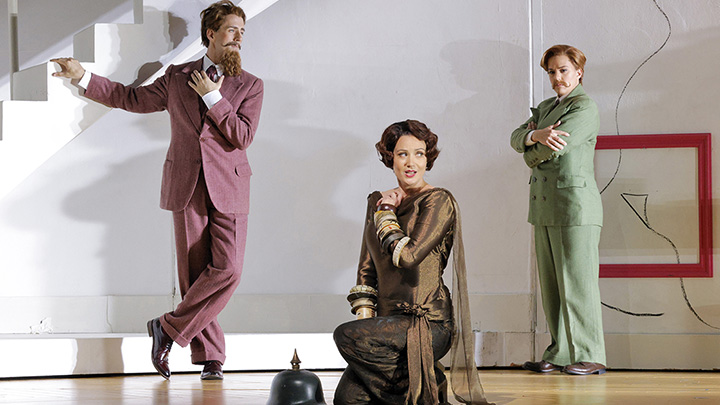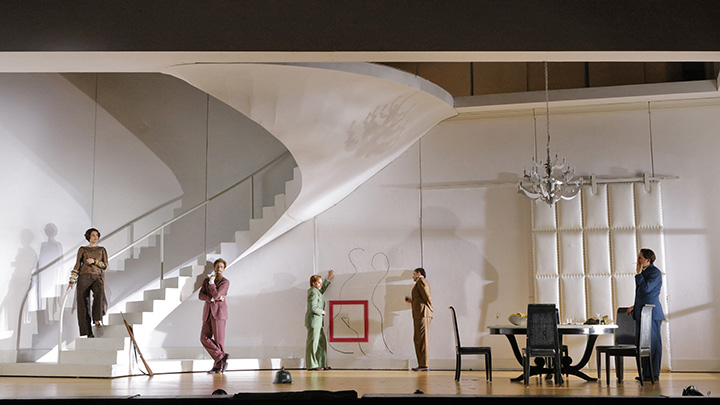In Napoli the place love is queen

By not attending, you’d be lacking out on one of the crucial electrifying performances of the season, for this gem of a revival of George Frideric Handel’s 1730 Partenope, which opened on Saturday, June fifteenth, sparkled brighter than Queen Charlotte’s diamonds, providing a singular and humorous tackle romantic relationships that’s undoubtedly to not be missed!
Partenope occupied a particular place in Handel’s opera oeuvre because it marked a return to a extra “comedian” opera seria since 1709’s Agrippina, by way of the lighter texture musically and humorous characteristically. Traditionally, it appeared in between the 2 Handel’s inventive peak trilogies, the 1724-25 collaborations with Nicola Francesco Haym — Giulio Cesare, Tamerlano, Rodelinda — and the 1733-35 variations of variations of Ludovico Ariosto, Orlando, Ariodante, and Alcina. In a evaluate, musicologist David Vickers asserted that Partenope, along with the well-known Serse and the penultimate Imeneo (all three tailored from Italian poet Silvio Stampiglia’s works), “kind an equally sensible and spectacular trilogy that stands beside its extra heroic or magical siblings,” a view that I unequivocally help.

Whereas Partenope’s plot was usually loosely described as the inspiration of the town of Naples (Partenope was the Queen of Naples) – thus bearing a passing resemblance to what Giulio Cesare did to Egypt – the opera was extra thinking about changing into ancient-time The Bachelorette, dwelling in frivolous romantic relationships between Partenope and three Princes plus a Shakespearean gender-swapping function. Our very personal Judith Malafronte, in certainly one of her two wonderful articles in this system notes (each had been important for understanding the opera and the manufacturing!), argues,
“May it have been the ever so barely feminist tone of the story that attracted the composer? Partenope’s two feminine characters blow the boys out of the water with their fortitude and complexity. As a substitute of heroic conflicts between love and obligation so widespread to Handel’s different works, we now have ‘a psychological examine of the relations between the sexes seen largely from the girl’s perspective,’ within the phrases of Handel scholar Winton Dean.
Because the Queen of Naples, Partenope boasts a set of suitors and enjoys enjoying them off towards one another. […] Rosmira, certainly one of Handel’s best mezzo-soprano roles, is extra complicated. She’s are available drag to Partenope’s courtroom to trace down the person who jilted her. Even when posing as ‘Eurimene,’ behind her willpower and interior torments we see the fascinating, passionate, and witty girl Rosmira is destined to be.”
The very nature of “feminist tone” was extensively explored in Christopher Alden’s manufacturing, right here staged by Affiliate Director Roy Rallo. A co-production of the English Nationwide Opera and Opera Australia, it premiered in London in October 2008 (even received an Olivier Award a 12 months later) earlier than gracing the Battle Memorial Opera Home stage for the primary time in October 2014. Within the phrases of ENO dramaturg Peter Littlefield:
“On this manufacturing, we took our inspiration from the Surrealists and their imaginative and prescient of the erotic nature of the psyche. […] We set Partenope’s courtroom in a salon. It’s an elite of socialites, males of affairs and artists who benefit from the day by day spherical of events, cocktails, and card video games. But every character is troubled by questions on what these relationships add as much as. […] It’s left to Ormonte to recommend an strategy that appears to elude the others: “In love as in a battle, you must take an opportunity.”
Certainly, this manufacturing, seen in both its authentic outing ten years in the past or in its revival final Saturday, struck an excellent steadiness between telling the story and having sufficient hijinks to be humorous (at all times an issue for mounting Handel’s “comedian” operas on an enormous stage). Transporting the story right into a Twenties Parisian salon with Partenope because the socialite was pure genius, a a lot better setting than an antiquated Neapolitan throne room (I guess no person within the viewers wished in any other case!). Equally memorable was the choice to solid Emilio – a prince of the neighboring kingdom of Cumae who ended up staying in Partenope’s courtroom and meddling within the affairs – because the Surrealist photographer Man Ray, even to the purpose of utilizing his Le Retour à la Raison movie as video projection in the course of the Act II battle scene! Not solely did it present a much-needed context to be a Surrealist-inspired setting, nevertheless it additionally gave an ideal cause why a defeated prince stayed in Partenope’s courtroom!

Moreover, this manufacturing was really forward of its time, and this revival felt extra topical now than ten years in the past. Partenope’s freedom to like whoever she needed actually felt extra urgent in mild of latest affairs, and Emilio/Man Ray’s obsession with photos positively mirrored the period of social media influencers. Heck, Partenope might simply be a satire for Taylor Swift!
Andrew Lieberman’s static units had been comparatively easy but efficient. Every act had a defining characteristic: a spiral staircase for Act I, a continuously visited rest room for Act II, and an overhanging ledge (sadly exhausting to see for folks sitting on the best aspect of the home) for Act III. Lieberman selected primarily monochromatic colours for the units. But, they had been introduced alive by the wonderful “shadow play” lighting of the revival lighting designer Gary Marder, offering good areas for the nonstop actions on stage. Rallo really outdid himself with the placements and actions of the singers, which maintained the light-hearted nature of the story with out being pressured. There was no park-and-bark on this battlefield of affection!
As spectacular because the manufacturing was, the musical facets of the evening really elevated the efficiency to a must-see degree. However first, the dangerous information! Within the curiosity of time, a number of cuts had been carried out to the rating, together with 4 arias from Act I, the Arsace/Rosmira duet “E vuoi, con dure tempre” in Act II, and three arias from Act III, together with varied recitative cuts and the Presto part of the Overture. Arsace suffered essentially the most, shedding three arias and that duet, sadly considerably weakening his characterization as he misplaced two of his bravura arias (extra on that later). Regardless of all these cuts, the present, with its two intermissions, nonetheless ran for round three and a half hours!
SF Opera assembled a rare solid for this revival from high to backside, anchored by two strong American and function debuts, French soprano Julie Fuchs within the title function and Italian countertenor Carlo Vistoli as Arsace! (They did have a knack for locating these superb singers this season, didn’t they?)
I had seen Fuchs twice earlier than, because the title function within the voyeuristic Calixto Bieito-directed L’incoronazione di Poppea in Zurich in 2019, adopted by Émilie within the uber-famous hip-hop impressed Les Indes Galantes the next 12 months. Nonetheless, her Partenope topped all these roles for me. After a slight tentativeness within the opening aria, “L’amor ed il destin” (in all probability brought on by nerves), she warmed as much as current a brilliant, spherical voice marked with superb phrasing and exquisite coloratura. The fascinating aria “Qual farfalletta” in Act II – the place Partenope “likens her love life to that of a butterfly flitting round a flame,” based on Malafronte – certainly demonstrated Fuchs’s appreciable skills from the clearly outlined fast coloratura, beautiful trills, to the convenience of going up and down the scales effortlessly. As well as, she seemed gorgeous in Jon Morrell’s robes (and tux!), and she or he clearly had a number of enjoyable enjoying the girl in cost. There was a sure sense of confidence in her appearing as Partenope, a girl who knew precisely what she needed, and that was really refreshing to see.
If something, Vistoli was even higher. As talked about above, Arsace misplaced three arias and a duet, together with two of his bravura arias. In consequence, Arsace had a string of feeble, shallow love arias that Vistoli made the very best of, singing with a candy tone and demonstrating brilliance often. It wasn’t till “Furibondo spira il vento” that closed Act II that the viewers had their eureka second, seeing what Vistoli might do! With rapid-fire coloratura, wonderful phrasing, a large number of nuances and colours, nice dynamics, and, above all, excellent breath management, Vistoli unleashed Arbace’s frustration of being torn between his want for Partenope and his love for Rosmira. His breath management was awe-inspiring, for he maintained all these lengthy, arduous coloratura passages in a single breath effortlessly whereas nonetheless shifting everywhere in the stage! After that, the viewers erupted in a loud rapture, an ideal solution to finish an act!
The opposite countertenor, New York-based Nicholas Tamagna, excelled because the lovesick pet Armindo. Enormously acclaimed in his debut as Narciso within the Metropolitan Opera’s latest Agrippina, which my colleague Christopher Corwin praised for his “depth and heartfelt singing,” Tamagna imbued his timid Armindo with a way of dignity and by no means let him fall into the pathetic class. Moreover, there was a level of heat in his voice that differentiated himself from Vistoli and afforded a grand stature to his characterization as Armindo, making him worthy of Partenope’s love ultimately. Tamagna, too, clearly had a lot enjoyable in the course of the song-and-dance quantity in Act III, “Nobil core che ben ama,” with out going overboard.

The husband-and-wife dynamic duo, tenor Alek Shrader and mezzo Daniela Mack, originated the roles of Emilio and Rosmira ten years in the past and introduced a better understanding to them this time round. Mack, contemporary from headlining final 12 months’s Frida y Diego and the latest new manufacturing of John Adams’s El Niño on the Met, personified the complicated dual-roles of Rosmira and Eurimene wholeheartedly, her darkish voice suitably sounded manly and noble. With Rosmira’s shedding her first “ballad” aria, her opening two bravura arias, together with “Io seguo sol fiero” that closed Act I, made the character statelier than the remaining. Mack executed the arias with ferocity, wearing inexperienced fits with a Salvador Dali-impressed thick mustache. In the meantime, Sharader’s voice had likewise grow to be extra outstanding and darker, giving the function of Emilio extra weight and gravitas than ten years in the past. However, he was nonetheless agile sufficient for Handel’s coloratura passages, making Emilio a completely rounded character. Baritone Hadleigh Adams, a veteran of SF Opera’s exhibits, rounded the solid together with his winsome take as Partenope’s homosexual greatest buddy and gave his greatest efficiency on the stage to date together with his rendition of Ormonte’s single aria, “T’appresta forse Amore,” wherein he, as Littlefield talked about above, taught a brand new strategy to like.
Conductor Christopher Moulds, who beforehand led Orlando, returned with an pressing studying for Partenope. He turned the SF Opera Orchestra right into a (momentary) Baroque ensemble, adopting varied HIP practices with out sacrificing the Orchestra’s authentic sounds (Sure, years of Halle Handel Festivals turned my ears extra accustomed to HIP ensembles). This was significantly evident in his main the orchestra throughout Arsace’s “Furibondo spira il vento.” With a zippy tempo and ferocious assaults on the strings, Moulds really introduced an avalanche within the accompaniment to match Arsace’s frame of mind!
This was an unbelievable achievement for SF Opera, an ideal Season nearer to rounding out an exceptionally splendid 2023/24 Season. And SF Opera, should you’re listening, how about Imeneo (or Tamerlano, ideally with Michael Spyres) subsequent, fairly please?
Photographs: Cory Weaver/San Francisco Opera

